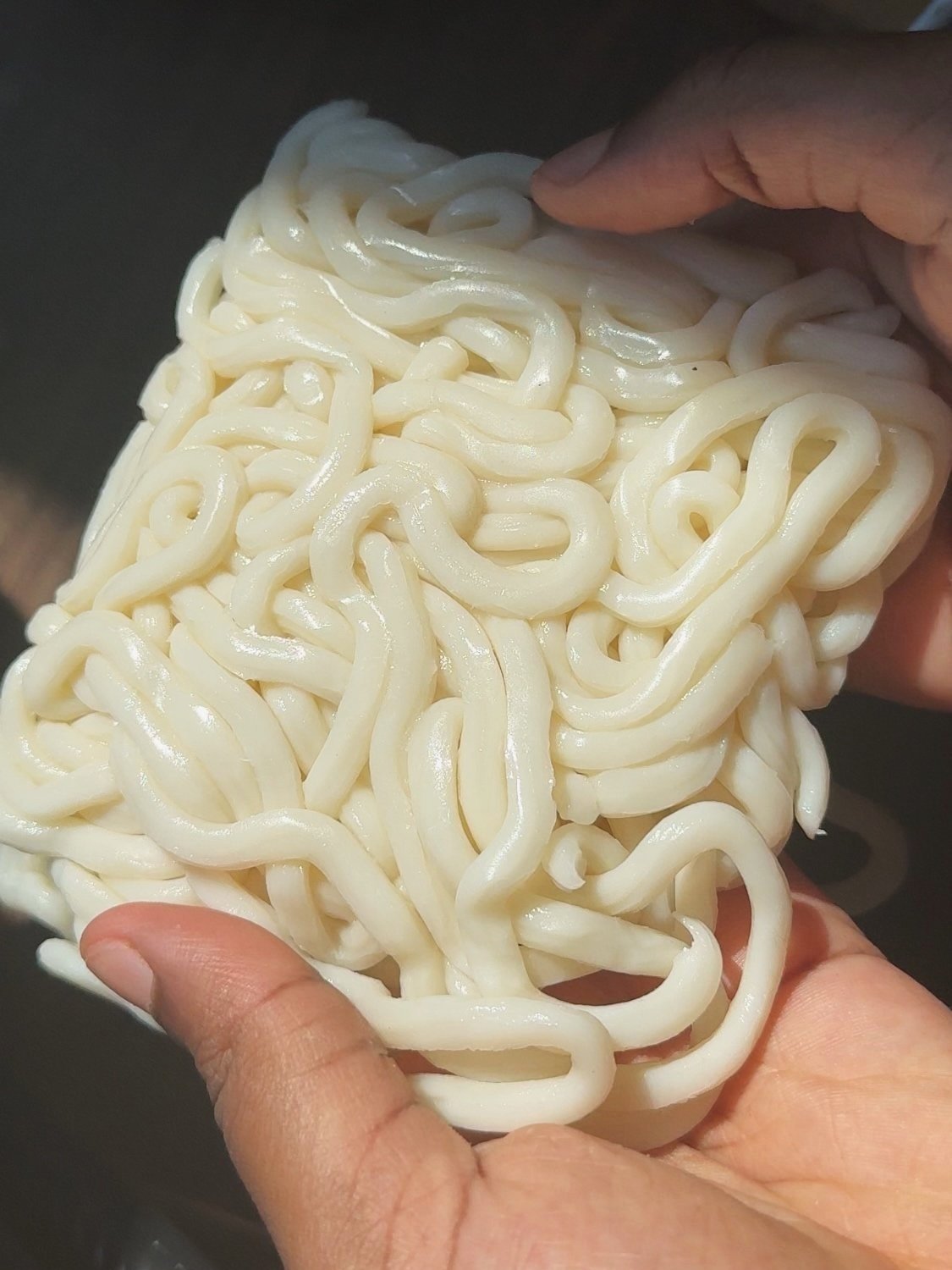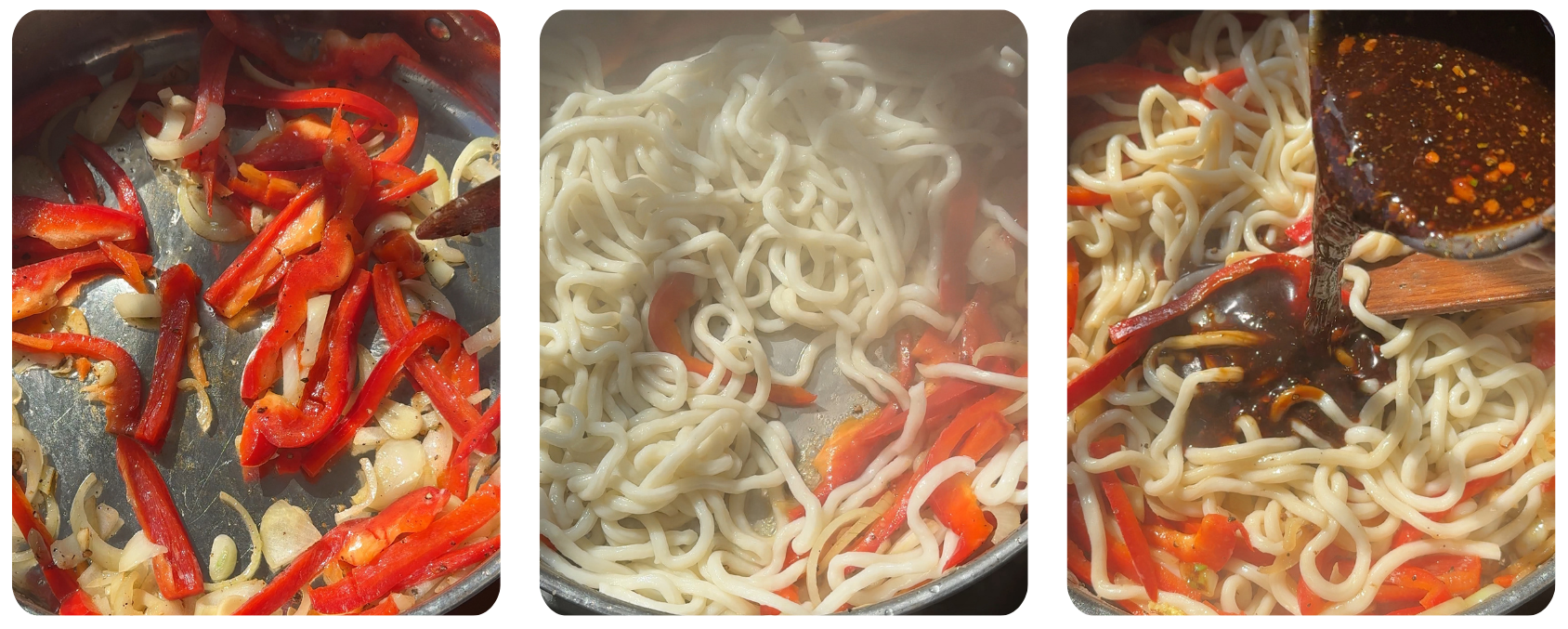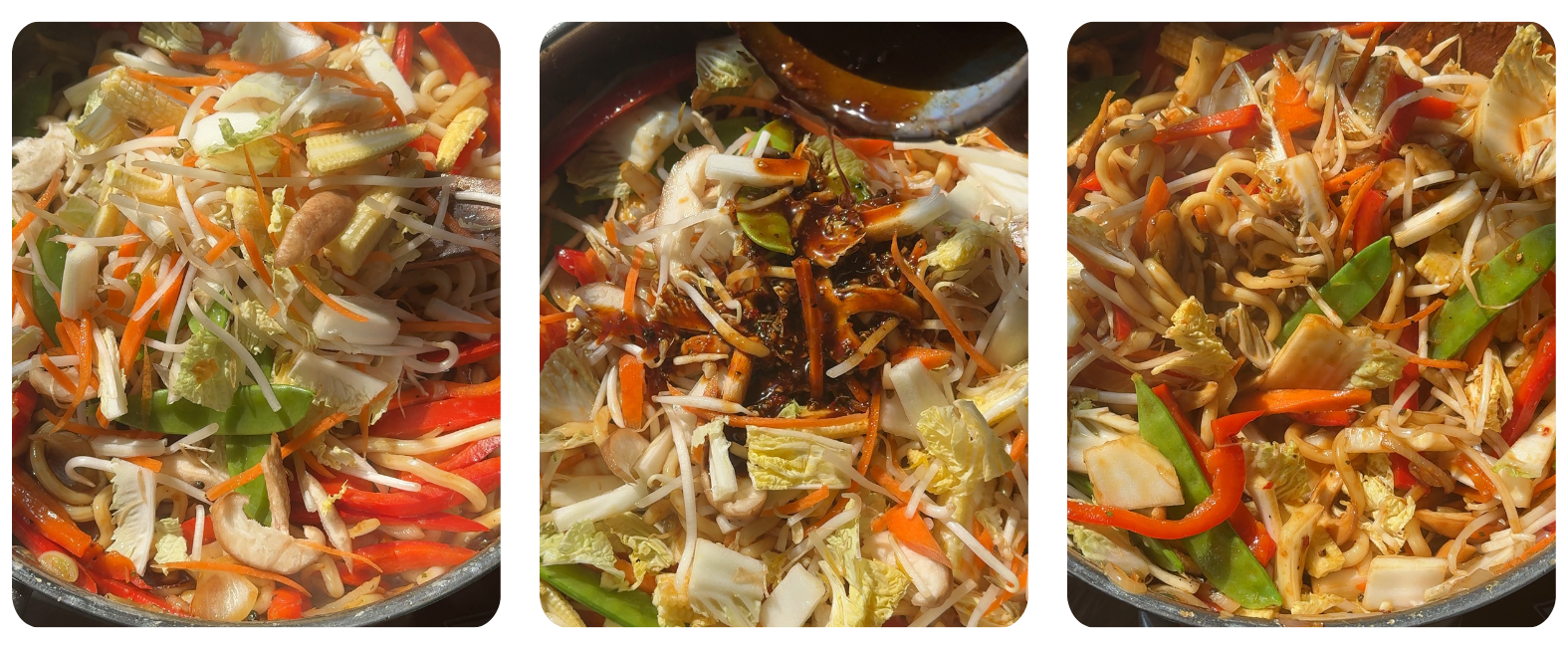Easy and Delicious Vegetable Yaki Udon
Crispy-tender veg, chewy udon, and a glossy, umami-rich sauce that coats every strand like a dream. This yaki udon recipe is your new weeknight go-to.
This is hands-down one of my favourite recipes to throw together when I want something comforting but packed with fibre and nutrients. The sauce is punchy and layered. Deep umami flavours from soy and oyster sauce, a bit of sweetness, a bit of vinegar to lift it all. And even though it’s loaded with fresh veggies, it doesn’t taste “healthy” in that sad, bland way. It’s rich, savoury, a little tangy, and you can tweak it endlessly depending on what you’ve got lying around.
Ingredients (Serves 2–3)
For the Vegetable Mix:
80g baby corn, halved
80g sugar snap peas or mange tout
150g beansprouts
1 carrot (~60g), julienned or thinly sliced
20g napa cabbage/chinese leaf, sliced
40g shiitake mushrooms, sliced
These veggies are chosen for their mix of crunch, freshness, and earthy depth. You can sub with whatever you’ve got — just aim for a good balance of texture.
Aromatics – Keep Separate:
1 large bell pepper, sliced
1 medium or 2 small onions, sliced
2 garlic cloves, sliced
Sauce:
2 tablespoons dark soy sauce (adds depth and colour)
3 tablespoons light soy sauce (for salt and that classic umami)
1 teaspoon garlic paste
1 tablespoon oyster sauce (sub with veg oyster sauce if needed)
1 teaspoon brown sugar (balances the salt)
1 teaspoon ketchup (adds tang + helps the sauce cling)
Optional: 1 tablespoon sesame paste or tahini (richness and subtle nutty flavour)
¼ teaspoon mixed herbs
¼ teaspoon freshly crushed black pepper (important it's freshly crushed, much more flavourful)
1 teaspoon rice vinegar (or white vinegar, this brightens it up)
Finishing Touches:
2 spring onions, finely sliced
1 teaspoon toasted sesame seeds (white or black, or both if you’re fancy)
Totally optional, but they add a pop of freshness, crunch, and that little “I know what I’m doing” energy to the final dish.
Step-by-Step Instructions
Step 1: Prep the Udon
Pour boiling water over 2 packets (400g) of vacuum-packed udon noodles in a large bowl.
Let sit for 7 minutes max, this softens them without making them mushy.
Drain and rinse thoroughly with cold water to stop the cooking and keep the noodles firm and bouncy.
Step 2: Make the Sauce
In a bowl or measuring jug, mix together:
2 tablespoons dark soy sauce
3 tablespoons light soy sauce
1 teaspoon garlic paste
1 tablespoon oyster sauce (vegetarian substitute works too!)
1 teaspoon brown sugar
1 teaspoon ketchup (yes, ketchup, don’t knock it, it adds a subtle sweetness, a little tang, and actually helps thicken the sauce)
¼ teaspoon mixed herbs
¼ teaspoon freshly crushed black pepper (not the pre-ground stuff, it matters here)
1 teaspoon rice vinegar (white vinegar is fine if that’s what you’ve got)
Optional: 1 tablespoon sesame paste or tahini for a nuttier, creamier depth
Whisk until combined. Taste it! Too salty? Add a splash of water. Too sweet? Add a touch more vinegar or soy. If you want heat, go ahead and throw in some chilli oil or flakes. This is your sauce base, your stir-fry foundation, your flavour blueprint, so tweak to taste and trust your gut.
Step 3: Get the Pan Hot
Use your biggest pan or a wok. You want it hot before the oil goes in — check for the Leidenfrost effect: flick water into the pan; if it sizzles and glides across like it’s dancing, you’re good to go.
Add 3 tbsp of neutral oil (sunflower, canola, veg oil). Let it heat for about 15 seconds.
Step 4: Start with Aromatics
Add the sliced onions and garlic. Sprinkle in a little more freshly crushed black pepper (trust me), and sauté for about 30 seconds until the onions start to go translucent.
Add 1 tsp garlic-ginger paste and stir quickly for another 10 seconds to bloom the flavour— but don’t let it sit too long or it’ll burn.
Step 5: Bell Peppers + Udon
Add the sliced bell peppers next. Stir-fry for 1 minute, you want them slightly softened but still bright.
Add your noodles. Let them sit for a few seconds to catch a little colour, then toss them.
Pour in half the sauce and stir well so the noodles are evenly coated.
Step 6: Layer the Veg
Toss in half of your colander veggies. Stir to combine and season lightly with salt (remember, the sauce is salty too).
Add the rest of the sauce, then the remaining veggies. Toss everything together over medium-high heat until the vegetables are cooked but still crisp, about 2–3 minutes total.
Optional: Squeeze in a little lime or lemon juice at this stage. It brightens the whole dish and makes the flavours pop.
Step 7: Finish + Garnish
If you like your noodles extra silky and rich, stir in 10g of butter now. It gives a glossy finish and rounds out the savoury notes beautifully.
Finish with:
Sliced spring onions
A sprinkle of sesame seeds
Optional drizzle of sesame oil or chilli oil
FAQ & Troubleshooting
What is udon?
Udon is a type of thick, chewy Japanese noodle made from wheat flour, water, and salt, and my personal favourite because it really soaks up sauce in the best way. It’s soft without being mushy, and it holds up amongst all the stir-fry chaos.
I don’t have Napa cabbage/Chinese leaf — can I just use normal white cabbage?
Totally. Napa cabbage is my go-to because it cooks quickly, absorbs flavour like a sponge, and holds its shape without going limp and sad. But if you’ve got regular white cabbage, use it. Just cut it into big chunks so it doesn’t cook down to mush.
Can I swap the sugar for honey?
Yup. The sugar helps round out the salt and tang, and honey does the same, with a little extra depth and gloss.
Why so much garlic, girl??
I love it. If that’s not your thing, cut it back. But at least try it once as written, you might be surprised at how balanced it ends up after everything mingles.
Help! My noodles keep sticking together!
Rinse them with cold water right after they’re softened to remove excess starch and stop the cooking.
Toss them with a little oil if they’re sitting around before going in the pan.
Make sure your pan is hot when they hit it, so they sear instead of steam and clump.
It’s too salty / not salty enough / too sweet / not sweet enough...
Taste. As. You. Go. That’s the #1 rule in any good stir-fry. The sauce is flexible, and your taste buds aren’t the same as mine. Start with the base, and tweak from there. Want more tang? Add vinegar. More depth? Try a dash more soy. Too salty? Add a splash of water or more veg.
How do I know if my udon noodles are cooked?
Udon isn’t like pasta where you’re going for al dente. With udon, you want that signature soft, chewy, bouncy texture.
If you’re using vacuum-sealed pre-cooked udon, you don’t really "cook" them, it’s just rehydrating and separating.
If you’re using frozen udon, boil them for 1–2 minutes max, just until they break apart and are heated through.
And if you somehow got your hands on fresh udon, follow package instructions, but again, aim for that soft bounce. Not gummy, not falling apart. Pull one out and bite it. If it feels satisfying to chew and holds its shape? You're good.
Thank you so much for reading! If you have any questions at all — about this recipe, how to tweak it to your taste, or even just to chat about food — I’d love to hear from you. Drop a comment below, DM me, or send me an email anytime.







